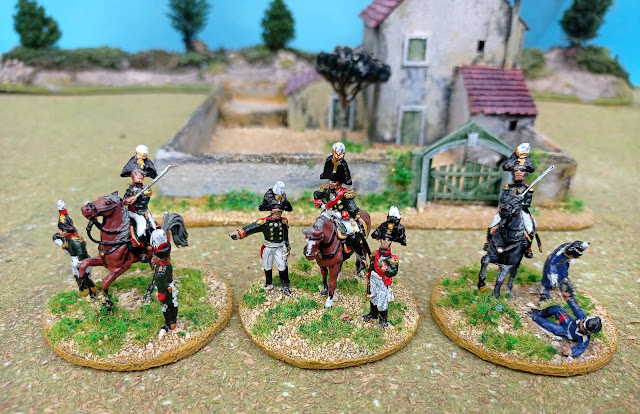One more project interrupted - Wagram 1809 - in order to give some room to my old Russians, glued for years to some ugly pieces of card, and to some "Revell Russians" I was thinking about for some time. In this post you can see some 400 figures but only half are new models with others being old Esci retouched and rebased.
The Borodino battle is a major event being the greatest battle of the Napoleonic wars until then (as Wagram was up to 1809). I remember that, as a kid, Tolstoy's War and Peace was the second book I read (the first was Robinson Crusoe) and I was dying to reach the battle descriptions which was not an easy task as the ones who read the book probably know! The movies that came out from the book are also great sources of inspiration.
Since then the Russian campaign of 1812 and Borodino, the Grand Armée, etc were always in my imagination. Another good thing about collecting figures for the Russian 1812 campaign is that the French still use the same uniform as in Wagram and the Peninsula which allows me use my Peninsular French. The only problem are the flags which are already the famous Tricolore in the Russian campaign while all my 20mm French have the 1807 flags.

As you can see the Revell Prussians give some reasonable Russians. In fact the Prussian uniform of 1813 is a copy of the Russian and even the Prussian shako is very close to the Russian Kiwer when covered as it makes a bulb at the top front . Then some paint for the metals and cords and there they go. Well, the shako is a bit taller at the front than at the rear but even the Esci Kiwer is taller then it should so everything goes nicely together. In fact only StreletsR portrays a good Kiwer in plastic but I will only go at these ones when the Esci and Revell figures are finished.
An advantage of the Prussian Revell over the the Esci Russians is that bayonets are fixed in all models as well as the blanket roll is placed on all torsos as the Russians did.
These grenadiers are the Esci figures with a plume made of a pin covered with Araldite resin, something made some 20 years ago or so.
Many of the flagbearers are Esci wounded, cornets or officers converted in order to hold the flag. The Esci Russians, even if beautifully sculpted, miss many blanket rolls and bayonets but look nice en masse.
A few more Esci converted grenadiers form the 2nd Combined Grenadier Battalion. They represent the 2nd brigade of the 23th division, part of the 4th infantry corps. Only five stands instead of six as this division was a bit understrength at Borodino (casualties?), the same happening with the jagers of this division.
The white I use on my Napoleonics is mixed with a bit of sand yellow in order to break the luminous white of most brands.
Also some brigades have the newer Zvezda as grenadiers. Fortunately I piled plenty of Zvezda boxes of Napoleonic Russians and, in a recent visit to the Flecha Negra in Madrid, I brought all that I could find as this excellent Russian brand is obviously very difficult to find nowadays.
This jager command stand has the Revell Prussian officer painted as Russian.
Now for some detail of the Revell "Russians" as I´m clearly trying to convincing you to do the same. I had five boxes of these figures in the stash from the days I was thinking to do late Napoleonics in 20mm. Later, with the cheap 28mm plastics, I ended up doing my late Prussians with Perry and Warlord figures. So these Prussians ended up a bit to the east following Kutusov and not Blücher.
The Revell Prussian flagbearers had the plastic flag cut out, the pole separated from its tip and the paper flag inserted. In the end the tip of the pole was glued together with a piece of plastic to compensate the larger paper flag. The Revell officer on horse has an Esci Russian shako instead of the original soft hat.
Same with this Revell flagbearer and stand.
Bird view of the first four Russian divisions (2nd and 4th Corps of Barclay de Tolly´s 1st Army of the West).
All Jagers up to now are Esci. I chose the winter uniform for the sake of diversity as it makes them distinguishable from the musketeers in summer uniform.
These old Esci Russian artillery are in fact bodies and guns from the Crimean War Esci box, so some 40 years wrong. Even so after placing the kiwer on them they look reasonable for the Napoleonic era even if in winter coats when Borodino was fought in summer.
Modelled together with this lot were these fantastic Mário Laranja houses. They make part of a much larger group of some 30 houses that Mário offered me at the same time of the WW2 Carentan city that you might have seen many posts ago. They were already built and I just had to base, apply black spray and paint them.
As usual they have an incredible amount of detail and everything is card!
These houses were made with the first few decades XIX century in Austria in mind, and that is a bit before the invasion of the open timber framing houses in the region which only happened in the mid century. Of course I painted them a bit generic so they can be used in different parts and periods of Europe.
An "Austrian" type of farm, again quite generic (the gate is resin and also made by Mário laranja), and inspired by the fantastic The Raft blog that you can see here:
https://wargamingraft.wordpress.com/2021/09/08/1809-terrain-3-austrian-villages/
Next: Russian command stands for Borodino.










































